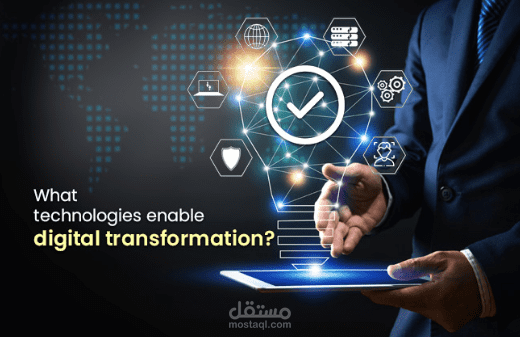Drivers of Digital Transformation according to the Author Chafaa Belaid Achour
تفاصيل العمل
1. Technological Programming Driver:
Software Development: Creating and developing customized software to enhance processes and achieve efficiency.
Artificial Intelligence and Machine Learning: Utilizing AI technologies to analyze data and make informed decisions.
Cybersecurity: Developing tools and techniques to protect data and information from cyber threats.
Service Integration: Incorporating AI-powered chatbots, virtual assistants, and automated customer support services to improve customer interactions.
2. Media or Technological Equipment and Means Driver:
Technological Hardware: Incorporating modern devices such as computers, servers, and networking equipment to improve performance.
Mobile Devices: Adopting mobile and tablet devices to enhance accessibility and remote work.
Augmented and Virtual Reality Technologies: Using these technologies in training, design, and user experiences.
Digital Services: Providing streaming services, cloud-based applications, and online platforms for better service delivery.
3. Product and Service Nature and Quality Driver:
Product Quality Improvement: Leveraging technology to ensure the accuracy and quality of products.
Personalization: Developing customized products and services that meet individual customer needs using data and analytics.
Sustainability: Adopting sustainable manufacturing and service delivery practices to reduce environmental impact.
Service Quality Enhancement: Implementing customer feedback systems and real-time service adjustments to ensure high-quality service delivery.
4. Business Process Driver:
Electronic Commerce Law: Regulations and laws that govern e-commerce and ensure the rights of sellers and buyers.
Mechanisms and Controls: Developing mechanisms and procedures that ensure efficient and transparent business processes.
Digital Marketing: Using digital marketing strategies to reach customers and increase sales.
Electronic Declaration: Simplifying declaration and registration processes online.
Electronic Insurance: Securing data and commercial transactions online to ensure safety and confidentiality.
Service Automation: Automating service processes such as billing, customer onboarding, and service delivery to improve efficiency.
5. Economic Process Driver:
Regulatory Institutions: Regulating and monitoring economic activities to ensure compliance with laws and standards.
Digital Accounting: Utilizing digital accounting systems to improve the accuracy and efficiency of accounting operations.
Financial Reporting: Enhancing financial reporting processes using digital tools to ensure transparency and accuracy.
Service Cost Management: Implementing digital tools for better cost management and financial planning of services.
6. Communications Institution Driver:
Communications Infrastructure: Developing communications networks to ensure fast and efficient data transfer.
Digital Communication: Enhancing digital communication methods between institutions and individuals.
Broadband Internet: Ensuring the availability of high-speed internet to support digital operations.
Customer Communication Services: Providing advanced customer service platforms, including live chat, video support, and social media interactions.
7. Technological Research Laboratories Driver:
Research and Development: Encouraging research in new technology fields and improving products and services.
Innovation: Supporting innovation and developing new technologies that contribute to digital transformation.
Scientific Collaboration: Enhancing collaboration between academic institutions and companies to develop advanced technological solutions.
Service Development: Innovating new service models and enhancing existing services through research and technology integration.
8. Electronic Administration Driver:
Operation: Adopting electronic management systems to improve efficiency.
Monitoring: Developing tools to monitor performance and ensure compliance with standards.
Evaluation: Using performance evaluation technologies to analyze data and make strategic decisions.
Service Management: Implementing digital tools for better service management, including scheduling, resource allocation, and performance tracking.
Conclusion
The theory emphasizes the importance of integrating these drivers to achieve successful and sustainable digital transformation. By focusing on these areas and incorporating both products and services, organizations can effectively navigate the digital transformation journey, improving performance and meeting the evolving needs of the market.
Author : CHAFAA BELAID ACHOUR
Writing date: 01.12.2022
Date of publication: 25/07/2024
